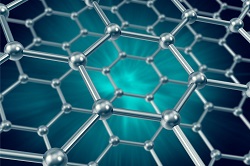Graphene boosts GHz signals into terahertz territory
Graphene – a one-atom-thick layer of hexagonally arranged carbon atoms – is the thinnest and strongest material known to man and an excellent conductor of heat and electricity. Since 2004, when researchers discovered how to extract it from graphite, graphene has opened new windows of opportunity in the world of science and technology. Over the past decade, scientists have predicted that its unique structure would make it especially efficient in converting optical or electronic signals into signals of much higher frequencies. However, all efforts to prove this were unsuccessful. Now, for the first time, a team of researchers, two of whom are supported by the EU-funded project EUCALL, have proved that graphene is actually able to convert electronic signals into signals in the terahertz range, with trillions of cycles per second. The team’s findings are presented in a study published in the journal ‘Nature’. Non-linear interaction The silicon-based electronic components used today generate clock speeds in the GHz range, where 1 GHz is equal to 1 000 million cycles per second. The scientists demonstrated that graphene can convert signals with these frequencies into signals with frequencies that are thousands of times higher than those created by silicon. What makes this feat possible is the highly efficient non-linear interaction between light and matter that occurs in graphene. The researchers used graphene containing a large number of free electrons that originated from the interaction between graphene and the substrate onto which it was deposited. When these electrons became excited by an oscillating electric field in room-temperature conditions, they rapidly shared their energy with bound electrons in the material. The electrons therefore reacted like a heated fluid, changing from liquid to vapour form inside the graphene within trillionths of a second. This transition led to powerful, rapid changes in the material’s conductivity, multiplying the frequency of the original GHz pulses. “We have now been able to provide the first direct proof of frequency multiplication from gigahertz to terahertz in a graphene monolayer and to generate electronic signals in the terahertz range with remarkable efficiency,” says co-author and Helmholtz Zentrum Dresden-Rossendorf (HZDR) senior scientist Dr Michael Gensch in a press release posted on the project partner’s website. High conversion efficiency The frequencies of the original electromagnetic pulses that were generated at HZDR’s TELBE terahertz facility ranged between 300 and 680 GHz. The scientists converted them into signals with three, five and seven times the initial frequency. “These conversion efficiencies are remarkably high, given that the electromagnetic interaction occurs in a single atomic layer,” the authors state in their study. The groundbreaking discovery supported by EUCALL (European Cluster of Advanced Laser Light Sources) makes graphene a promising candidate for the nanoelectronics of the future. For more information, please see: EUCALL project website
Countries
Germany



